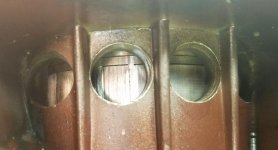Hi all. Quick background - dug out my grandad's old Speeditwin 28hp and went through it pretty thoroughly. Replaced bearings / resealed lower unit, bored out block, new pistons/rings (.40 over), new fuel pump/lines, replaced all electrical components, rebuilt the carb and put everything back together with new gaskets.
I understand there is a pretty specific break in procedure and am currently running 24:1 (non-ethanol) mix through my engine. I have so far ran roughly 6gal through my engine, initially running it at fast idle, keeping the speed varied and eventually taking it out on the water to get the engine speed a little higher.
Problem is it doesn't seem to run 'well', regardless of where I set my high speed setting. Towards the end of my tank I was finally able to get it on plane for a few brief seconds, but a couple of times the engine would slow down and basically seize up when it was under power. Which leads me to my question - it is possible my pistons/rings are too tight and it just needs to be broken in more? I verified the ring gap was within tolerance before installing the pistons, but it feels like they're getting hot under load and making the engine stop. Once the engine cools for a sec, its able to run again, but I stopped running it for fear of doing further damage.
I understand there is a pretty specific break in procedure and am currently running 24:1 (non-ethanol) mix through my engine. I have so far ran roughly 6gal through my engine, initially running it at fast idle, keeping the speed varied and eventually taking it out on the water to get the engine speed a little higher.
Problem is it doesn't seem to run 'well', regardless of where I set my high speed setting. Towards the end of my tank I was finally able to get it on plane for a few brief seconds, but a couple of times the engine would slow down and basically seize up when it was under power. Which leads me to my question - it is possible my pistons/rings are too tight and it just needs to be broken in more? I verified the ring gap was within tolerance before installing the pistons, but it feels like they're getting hot under load and making the engine stop. Once the engine cools for a sec, its able to run again, but I stopped running it for fear of doing further damage.


